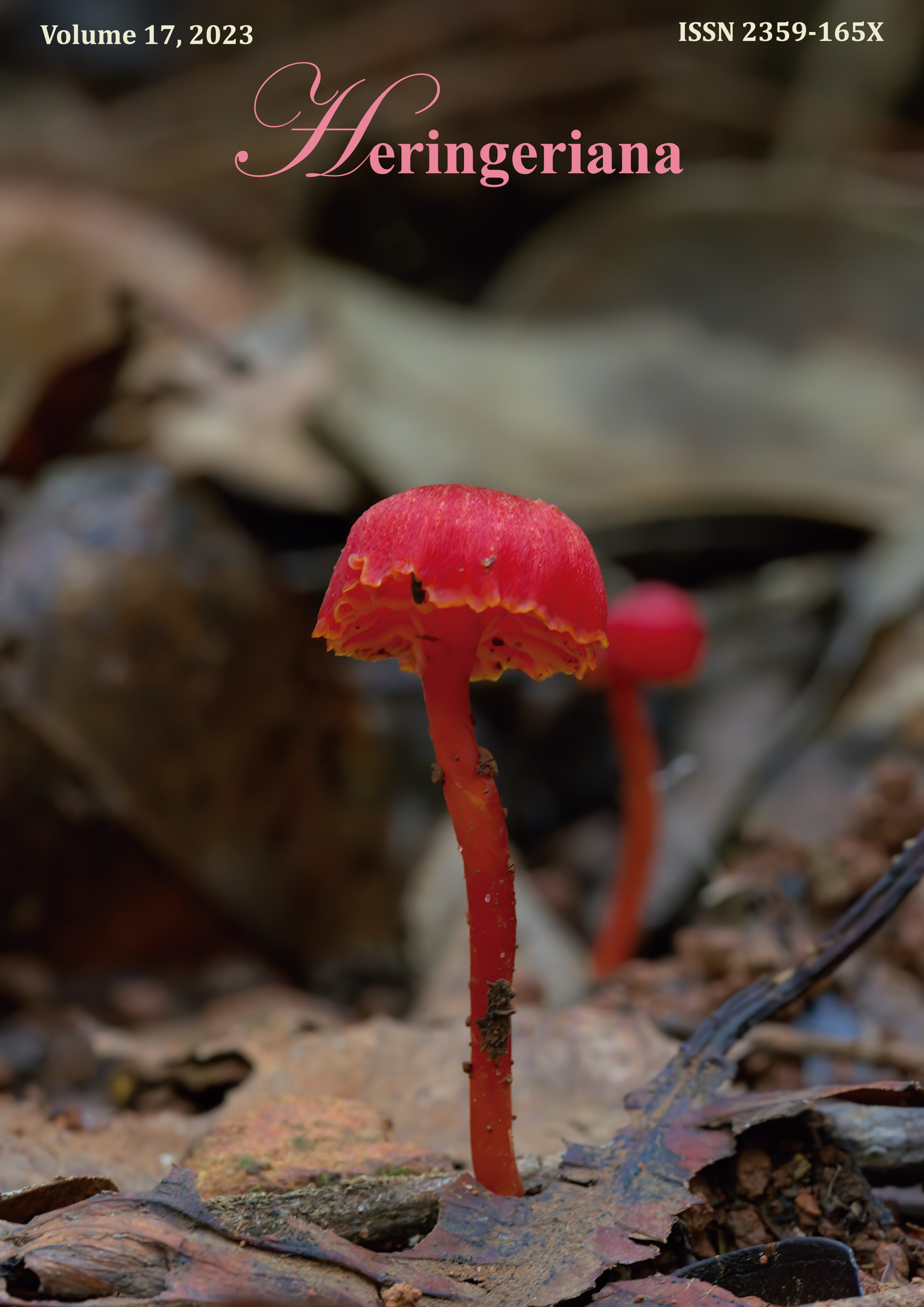Oxybelis aeneus (Wagler 1824): novo registro de predação e lista de dieta atualizada
DOI:
https://doi.org/10.17648/heringeriana.v17i1.918024Referências
Aguiar, L.F.S. & Di-Bernardo, M. (2004) Diet and feeding behavior of Helicops infrataeniatus (Serpentes: Colubridae: Xenodontinae) in southern Brazil. Studies on the Neotropical Fauna and Environment 39: 7-14. https://doi.org/10.1080/01650520412331270927.
Almeida, G.V., Silva, G.L., Campos, T.F., Muniz, S.L. & Santos, E.M. (2009) Predação do lagarto Tropidurus cocorobensis pela serpente Oxybelis aeneus. Boletim do Museu de Biologia Mello Leitão 25: 83-86.
Ávila-Pires, T.C.S. (1995) Lizards of Brazilian Amazonian (Reptilia: Squamata). Zoologische verhandelingen 299: 1-706.
Barquero, M.D. (2018) Oxybelis aeneus: aggressive interactions with the clay-colored trush (Turdus grayi). Herpetological Bulletin 143: 43. Available at: https://www.thebhs.org/publications/the-herpetological-bulletin/issue-number-143-spring-2018/1819-12-i-oxybelis-aeneus-i-aggressive-interactions-with-the-clay-colored-trush-i-turdus-grayi-i (accessed: 1 June 2023).
Beebe, W. (1946) Field notes on the snakes of Kartabo, British Guiana, and Caripito, Venezuela. Zoologica 31: 11-52. http://dx.doi.org/10.29215/pecen.v2i1.587
Campos, F.S., Lage, A.R. & Lourenço-de-Moraes, R. (2022) Predation of Gymnodactylus darwinii (Squamata Phyllodactylidae) by Oxybelis aeneus (Squamata Colubridae) in Morro de São Paulo (Tinharé Island), Northeastern Brazil. Herpetology Notes 15: 97-99. Available at: https://www.biotaxa.org/hn/article/view/68084 (accessed: 1 June 2023).
Carvalho, C.B., Freitas, E.B., Faria, R.G., Batista, R.C., Batista, C.C., Coelho, W.A. & Bocchiglieri, A. (2008) História natural de Leptodactylus mystacinus e Leptodactylus fuscus (Anura: Leptodactylidae) no Cerrado do Brasil Central. Biota Neotropica 8: 105-115. https://doi.org/10.1590/S1676-06032008000300010.
Censky, E.J. & McCoy, C.J. (1988) Female reproductive cycles of five species of snakes (Reptilia: Colubridae) from the Yucatan Peninsula, Mexico. Biotropica 20: 326-333. https://doi.org/10.2307/2388323.
Costa, F.R.F., Pezeta, Y.F., Crozariol, M.A., de Oliveira, T.P., Henderson, R.W., & Gonzalez, R.C. (2022) A review of the diet of Oxybelis aeneus group (Squamata: Colubridae) including two new prey records from north-eastern Brazil. Herpetology Notes 15: 785-795. Available at: https://www.biotaxa.org/hn/article/view/73820 (accessed: 1 June 2023).
Cunha, O.R. & Nascimento, F.P. (1978). Ofídios da Amazônia. X - As cobras da região leste do Pará. Belém. Museu Paraense Emílio Goeldi, 218 p.
Cunha, O.R. & Nascimento, F.P. (1993). Ofídios da Amazônia. As cobras da região Leste do Pará. Boletim do Museu Paraense Emílio Goeldi: série zoologia, 9: 1-191.
França, F.G.R. & Araújo, A.F.B. (2007) Are there co-occurrence patterns that structure snake communities in Central Brazil? Brazilian Journal of Biology 67: 33-40. https://doi.org/10.1590/S1519-69842007000100005.
França, F.G.R., Mesquita, D.O., Nogueira, C.C. & Araújo, A.F.B. (2008) Phylogeny and ecology determine morphological structure in a snake assemblage in the Central Brazilian Cerrado. Copeia 2008: 23-38. https://doi.org/10.1643/CH-05-034.
Franzini, L.D., Pedro, C.K.B., Cavalcanti, L.B.Q. & Mesquita, D.O. (2018) Predation of Hemidactylus mabouia (Sauria: Gekkonidae) by a vine snake Oxybelis aeneus (Serpentes: Colubridae) in an Atlantic Forest fragment, northeastern Brazil. Pesquisa e Ensino em Ciências Exatas e da Natureza 2: 67-70. http://dx.doi.org/10.29215/pecen.v2i1.587
Goldberg, S.R. & Bursey, C.R. (2001) Hypsiglena torquata (Night snake) and Oxybelis aeneus (Brown vine snake). Endoparasites. Herpetological Review 32: 263.
Jadin, R.C., Blair, C., Jowers, M.J., Carmona, A., & Murphy, J.C. (2019) Hiding in the lianas of the tree of life: molecular phylogenetics and species delimitation reveal considerable cryptic diversity of New World Vine Snakes. Molecular Phylogenetics and Evolution 134: 61-65. https://doi.org/10.1016/j.ympev.2019.01.022
Jadin, R.C., Blair, C., Orlofske, S.A., Jowers, M.J., Rivas, G.A., Vitt, L.J., ... & Murphy, J. C. (2020) Not withering on the evolutionary vine: systematic revision of the Brown Vine Snake (Reptilia: Squamata: Oxybelis) from its northern distribution. Organisms Diversity and Evolution 20: 723-746. https://doi.org/10.1007/s13127-020-00461-0.
Jadin, R.C., Jowers, M.J., Orlofske, S.A., Duellman, W.E., Blair, C., & Murphy, J.C. (2021) A new vine snake (Reptilia, Colubridae, Oxybelis) from Peru and redescription of O. acuminatus. Evolutionary Systematics 5: 1-12. https://doi.org/10.3897/evolsyst.5.60626
Keiser Jr., E.D. (1982) Oxybelis aeneus (Wagler). Catalogue of American Amphibians and Reptiles 305: 1-4.
Martins, M. & Oliveira, M.E. (1998) Natural history of snakes in forests of the Manaus region, Central Amazonia, Brazil. Herpetological Natural History 6: 78-150.
Mesquita, P.C., Passos, D.C., Borges-Nojosa, D.M. & Cechin, S. Z. (2013) Ecologia e história natural das serpentes de uma área de Caatinga no nordeste brasileiro. Papéis Avulsos de Zoologia 53: 99-113. https://doi.org/10.1590/S0031-10492013000800001.
Mesquita, P.C.M.D., Borges-Nojosa, D.M., Passos, D.C. & Bezerra, C.H. (2012) Activity patterns of the Brown Vine snake Oxybelis aeneus (Wagler, 1824) (Serpentes, Colubridae) in the Brazilian semiarid. Animal Biology 62: 289-299.
https://doi.org/10.1163/157075611X618228.
Nogueira, C.C., Argôlo, A.J., Arzamendia, V., Azevedo, J.A., Barbo, F.E., Bérnils, R.S., ..., & Martins, M. (2019): Atlas of Brazilian snakes: verified point-locality maps to mitigate the Wallacean shortfall in a megadiverse snake fauna. South American Journal of Herpetology 14: 1-274. https://doi.org/10.2994/SAJH-D-19-00120.1
Oliveira, C.R., Brasileiro, A.C. & Mascarenhas, W. (2020) Oxybelis aeneus (Brown Vine Snake). Diet. Herpetological Review 51: 876.
Oliveira, M., Gottschalk, M.S., Loebmann, D., Santos, M.B., Miranda, S., Rosa, C. & Tozetti, A.M. (2015) Diet composition and niche overlap in two sympatric species of Physalaemus (Anura, Leptodactylidae, Leiuperinae) in coastal subtemperate wetlands. Herpetology Notes 8: 173-177.
Oliveira-Souza, A.E., Pena, A.S., Costa-Anaissi, J.S., Melo, F.S., Pinheiro, R.T. & Costa-Campos, C.E. (2021) Predation by the vinesnake Oxybelis aeneus (Squamata, Colubridae) on the gecko Gonatodes humeralis (Squamata, Sphaerodactylidae) in a Brazilian Amazon forest fragment, with a compilation of its prey. Herpetology Notes 14: 1111-1115.
Queiroz, L.P.D. (2009) Leguminosas da caatinga. Universidade Estadual de Feira de Santana.
Recoder, R., Junior, M.T., Camacho, A. & Rodrigues, M.T. (2012) Natural history of the tropical gecko Phyllopezus pollicaris (Squamata, Phyllodactylidae) from a sandstone outcrop in Central Brazil. Herpetology Notes 5: 49-58.
Santos, R.A., Santana, D.O., Caldas, F.L.S. & Faria, R.G. (2012) Tropidurus hygomi (Reinhardt’s Lava Lizard). Predation. Herpetological Review 43: 490-491.
Sawaya, R.J., Marques, O.A.V. & Martins, M. (2008) Composição e história natural das serpentes de cerrado de Itirapina, São Paulo, sudeste do Brasil. Biota Neotropica 8: 127‑148. https://doi.org/10.1590/S1676-06032008000200015
Shine R. (ed.) (1995) Australian Snakes: A Natural History. Ithaca, Cornell University Press.
Silva N.V.N., Mello, A.V.A., Oliveira, P.M.D.A., de Andrade Lima, J.H., de Castro Ribeiro, L.R. & Simões, P.I. (2021) Predation of Ameivula ocellifera (Squamata, Teiidae) by Oxybelis aeneus (Squamata, Colubridae), in the Caatinga, Northeastern Brazil, including a list of saurophagy by this snake. Heringeriana 15: 96-100. https://doi.org/17648/heringeriana.v15i1.917960.
Silva, M.V., Souza, M.B. & Bernarde, P.S. (2010) Riqueza e dieta de serpentes do Estado do Acre, Brasil. Revista Brasileira de Zoociências 12: 165-176.
Vitt, L.J. & Vangilder, L.D. (1983) Ecology of a snake community in Northeastern Brazil. Amphibia-Reptilia 4: 273-296. https://doi.org/10.1163/156853883X00148
Downloads
Publicado
Como Citar
Edição
Seção
Licença
Copyright (c) 2023 Cicero Ricardo Oliveira, Alcéster Diego Coelho-Lima, Ana Carolina Brasileiro, Lyse Panelli de Castro Meira

Este trabalho está licenciado sob uma licença Creative Commons Attribution 4.0 International License.
Ao fazer a submissão, os autores declaram não ter submetido o trabalho a outra revista e concordam em ter seu artigo publicado sob Licença Creative Commons Atribuição 4.0 Internacional BY (CC BY 4.0), que significa que os autores mantêm a propriedade dos direitos autorais, mas qualquer pessoa pode usar o conteúdo publicado, desde que os autores originais e a fonte sejam citados. O conteúdo científico, ortográfico e gramatical é de total responsabilidade dos autores.








